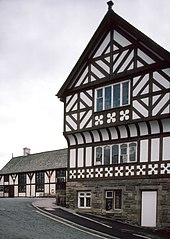Ruthin
Ruthin [ rɪθɪn ] ( Welsh Rhuthun [ r̩ɪθɪn ]) is the administrative seat with community status in the county of Denbighshire in North Wales .
The village of Ruthin is located in the southern part of the Clwyd Valley. The houses are grouped around a hill; the older part of the village, Ruthin Castle and Saint Peter's Square, is on the hill, while many of the younger parts are in the floodplain of the river. The castle, which was built from the red sandstone from the area, dates back to 1277 when the town began to be fortified. The building was preserved until the 17th century; it has been partially restored in recent times and is now one of the most luxurious hotels in Wales, known for medieval banquets with harp music.
history
Little is known about the city's history before 1277. At that time Dafydd , the brother of Llywelyn ap Gruffydd, had started building Ruthin Castle. However, he had to give up the castle when he and his brother against King I. Edward rebelled. Around 1281 the castle was the residence of Edward's wife Eleonore , so the complex must have been largely completed by this time.
Dyffryn Clwyd's Cantref County was given to Reginald Gray , Justiciar of Chester ; his family held that position for the next 226 years. A dispute between Reginald Gray, 3rd Baron Gray de Ruthin and Owain Glyndŵr ultimately triggered the rebellion against English rule , which began on September 18, 1400. Glyndŵr burned the city of Ruthin first; only the castle and a few houses are said to have remained intact.
During the English Civil War, parliamentary troops besieged the castle for eleven weeks and then razed it. In the 19th century, parts of the complex were rebuilt as a country house, today's Ruthin Castle Hotel.
In 1863 the Vale of Clwyd Railway reached the city; the railway line ran from Rhyl via Ruthin to Corwen , where it had connections to Llangollen and Barmouth . The railway line was officially closed in 1963; but there had been no more trains between Ruthin and Corwen because of a landslide. The place where the station buildings stood is now taken up by a large roundabout and the Ruthin Craft Center.
Cityscape
Ruthin is now a wealthy community, and magnificent black and white half-timbered houses dominate the cityscape. They date from the 14th to 17th centuries. Significant buildings are:
- Pendref Chapel: oldest free church in the city and built in 1827.
- Old Courthaus: remarkable medieval building from the 14th century.
- Maen Huail: heavy stone with a recess and, according to legend, the scaffold when King Arthur had his adversary Huail beheaded.
- St Peter's Church: Church from the 13th and 14th centuries with a magnificent late Gothic ceiling, consisting of 480 carved oak panels, a gift from Henry VII. The magnificent wrought iron gates on the south side of the parish church are the work of the brothers Robert and John Davies; Robert Davies was the most important Welsh blacksmith of the 18th century.
- Myddelton Arms: 16th century Dutch style house with seven unusually arranged dormers , built by Sir Richard Cough.
- Nantclwyd House: oldest half-timbered mansion of Ruthin from 1314; it is said to be one of two houses that remained after Owain Glyndwr burned the town.
- County Hall: the structure was constructed between 1785 and 1790; The architect was Joseph Turner.
- Old County Gaol: Built as a model Denbighshire prison in 1775 and closed in 1916.
- Wynnstay Arms: Half-timbered house from the 16th century, then a "coaching inn".
sons and daughters of the town
- Tom Pryce (1949–1977), British racing car driver
- Joe Woolford (born 1994), singer
swell
- HE Conrad: Wales ; Prestel Verlag, Munich 1982, ISBN 3-7913-0594-8 , p. 200.
Web links
- Ruthin Attractions. VisitRuthin.wales (English)
Coordinates: 53 ° 7 ′ N , 3 ° 19 ′ W


